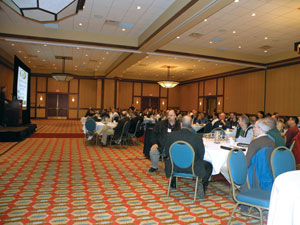
Biomass Is Booming
December 4, 2009
By Heather Hager PhD
There was a whole lot of networking going on at the Canadian Bioenergy
Association (Canbio)’s annual conference and trade show. Over 100
participants and various exhibitors from Canada, Finland, and Sweden
converged on Edmonton in late October 2009 to discuss Canada’s
developing biomass economy.

|
|
| Conference participants learn that feedstocks and financing are the top two concerns in developing a bioenergy project.
|
There was a whole lot of networking going on at the Canadian Bioenergy Association (Canbio)’s annual conference and trade show. Over 100 participants and various exhibitors from Canada, Finland, and Sweden converged on Edmonton in late October 2009 to discuss Canada’s developing biomass economy. Topics during the two days of talks ranged from biomass supplies, quality issues, and harvesting guidelines to emerging biomass technologies, project overviews, and financing. The conference concluded on day three with a tour of local upcoming projects such as Enerkem’s waste-to-ethanol facility and Highmark Renewables’ massive anaerobic digester.
Canbio VP Prairies Jamie Bakos opened day one by setting three goals for the conference. He challenged each participant to make 10 new contacts and to strengthen relationships with existing contacts, with an overall goal of moving the biomass business forward. Certainly, participants were keen to meet these challenges, as was evidenced by the bustle of activity. During breaks throughout the conference, participants could be found visiting the adjoining trade show and talking with fellow attendees.
BIOMASS SUPPLY
The first topic of the day, and the primary consideration in any bioenergy project, is where to get a long-term supply of biomass. Prior to the recent major sawmill shutdowns, there was plenty of sawmill residue to go around and more, says Douglas Bradley, Canbio president. Over the past couple of years, however, that surplus has disappeared, and operations have had to find residue elsewhere or shut down. So the focus has shifted to nonmerchantable timber and slash, previously ignored because of high costs associated with its removal and delivery.
But bioenergy developers aren’t always involved in forestry. “Bioenergy companies don’t necessarily want to manage the forest, but rather, they want to concentrate on the new bioenergy industry,” remarks Larry Stanley of Saskatchewan Energy and Resources. This means that bioenergy companies are looking to contract long-term biomass supplies from reliable providers.
The move to forest-based sources of biomass brings its own issues. “The weakness we’re seeing across Canada is a lack of emphasis on the quality of forest residues that suppliers are delivering,” notes Mark Ryans of FPInnovations. “The customer sets the feedstock requirement, and wants homogeneous and predictable quality.” He says the top three quality factors are appropriate moisture content, consistent particle size, and clean material.
The seasonal variability of the resource means that suppliers need to figure out how to deliver a year-round supply with appropriate moisture content. Methods such as pre-piling and covering with a tarp are being tested. A 10% reduction in moisture content can have a good return on investment because it means a supplier transports more energy content and less water per tonne of biomass, says Ryans.
Of course, a discussion of the biomass supply would not be complete without considering sustainability. These days, the public perception is that bioenergy will cause the large-scale decimation of old- and second-growth forests. An overview of provincial forest residue harvest policies and guidelines by experts such as Evelyne Thiffault of Natural Resources Canada, Don Gosnell of the British Columbia Ministry of Forests and Range, Pat Guidera of Alberta Sustainable Resource Development, and Larry Stanley of Saskatchewan Energy and Resources indicates otherwise. Rather than burning slash in the field or leaving it at the roadside, some provinces are now re-allocating leftover fibre to other parties if the primary harvester does not want to use it. Other provinces are implementing guidelines for where and how much biomass can be removed with the timber harvest.

|
|
| On day two, a panel of resource specialists discussed forest residue harvesting policies. Left to right: Don Gosnell, B.C. Ministry of Forests and Range; Pat Guidera, Alberta Sustainable Resource Development; Larry Stanley, Saskatchewan Energy and Resources; Evelyne Thiffault, Natural Resources Canada; JP Gladu, Aboriginal Strategy Group.
|
FROM SLASH TO CASH
Uses for the harvested and delivered forest-based biomass are expanding as new technologies move forward. Gasification, cellulosic ethanol, biorefining, pyrolysis, biocarbon—these are the potential future of biomass. Presenters from Enerkem, Lignol, Taylor Gasification, and Alterna Energy talked about the status of their technologies and projects and answered attendees’ questions about settings and specs.
Participants also heard from individuals and groups from Finland, Sweden, and Canada that provide project development services. As more experience is gained in putting together bioenergy projects, it makes sense to take advantage of that knowledge and avoid past mistakes. Several speakers stressed the importance of using proven equipment and technology to avoid failures and develop good projects as successful demonstrations. “The new stuff will be developed later,” says Jouko Parviainen of Wenet (Wood Energy Network), Finland.
An example of a highly successful project in eastern Finland was presented by Dominik Röser of Metla (Finnish Forest Research Institute). The Eno Energy Co-op uses local biomass resources to provide district heating for the municipality. According to Metla, about 52% of forest in Finland is privately owned and supplies 80–90% of wood used by the forest industry. After several years of planning, the co-op began in 1999 with just 12 members. It now owns two and operates three combustion plants supplying district heating and boasts 51 members. It is one of the most visited projects in the European Union as a successful model of district heating, says Röser. The project resulted in cost savings by replacing more expensive oil heating and created jobs in the community.
A Swedish example of efficient biomass use was provided by Christofer Rhén of Green-Exergy, which designs and commissions combined heat, power, and pellet (CHPP) plants. Two reference plants have been producing CHPP in Sweden since 1996 and 2008, respectively. Adding pellet production to combined heat and power (CHP) results in greater efficiencies of energy use, even with wet biomass, says Rhén. He estimates efficiencies at 35% for electricity alone, 88% for CHP, and up to 98% for CHPP.
Up-and-coming showcase technologies and projects provide examples of where the bioenergy industry can go, but unless a person is independently wealthy, capital investment and financing are a second key consideration. A show of hands elicited by Reg Renner of Atticus Financial indicated that various participants were actively seeking financing for equipment and other costs. However, a second show of hands, or rather of no hands, revealed the absence of people looking to finance bioenergy projects.
“Preparing a project to apply for financing is like training for the Olympics,” says Renner. Focus, a coach and team, equipment, timelines, and preparation aren’t just for world-class athletes, he says. They can go a long way towards showing a potential financier that the project can be successful and profitable.
“You must prepare to approach an investor like you’d prepare for a job interview,” says Corey Keith of Keith & Associates. “Make sure you do your homework.” He emphasises that a clear, simple, targeted approach is best and that potential investors will want to know that worst-case scenarios can be addressed successfully. A realistic valuation of the enterprise is critical. Keith notes that most applicants on the Canadian television show Dragon’s Den fail to hook an investor because they value their company at way more than it’s worth.
There’s enough biomass available in Canada to support many more projects, be they wood pellet plants, biorefineries, community heat and power, or industrial CHPP. The cost of accessibility is the limitation. In Europe, people are willing to pay more for wood energy because they value it as more environmentally responsible than fossil energy, says Röser. Biomass and bioenergy must also become more valuable in Canada to support the domestic industry’s expansion. •
Print this page